Frequency
| Frequency Generation |
Frequency
The square waveform is chosen above all other waveform's because of its rich harmonic content. The harmonic content far exceeds that of other waveform's.
Harmonics Defined
It is extremely important that any user of resonant frequency technologies comprehend each of the definitions regarding harmonics
har·mon·ic (här-m ![]() n
n ![]()
![]() k) n.
k) n.
- Any of a series of musical tones whose frequencies are integral multiples of the frequency of a fundamental tone.
- A tone produced on a stringed instrument by lightly touching an open or stopped vibrating string at a given fraction of its length so that both segments vibrate. Also called overtone, partial, partial tone .
- harmonics (used with a sing. verb) The theory or study of the physical properties and characteristics of musical sound.
- Physics. A wave whose frequency is a whole-number multiple of that of another.
Source: The American Heritage® Dictionary of the English Language, Fourth Edition
As mentioned above, we use square waves because they are "harmonic rich".
A practical demonstration of frequency, harmonics, and resonance, might be best demonstrated through the analogy of the piano. Whereas, the player hits the single note "middle C" on the keyboard. The hammer clearly strikes ONLY the strings of middle C causing them to vibrate. Every other "C" string on the piano also begins to "sympathetically" vibrate, also releasing its individual sound. The further away from the original set of strings, the less intense (amplitude) the sound. The RIFEforLIFE SquareGEN pro Spectrum Analyzer here has been used to display and capture these harmonic sounds and clearly shows the mathematically periodic harmonics of the single fundamental frequency.
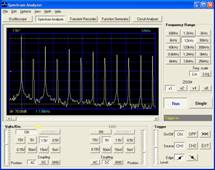
SquareGEN pro Spectrum Analyzer
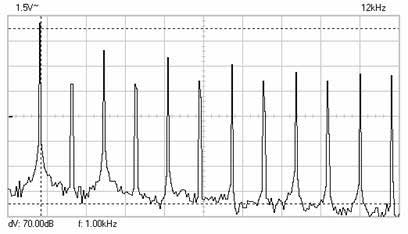
Square Wave at 1000 Hz (1kHz)
The 1000 Hz square wave being generated here, (known as the fundamental frequency), clearly shows in the spectral analysis of the regular harmonics, multiples of the actual frequency, up the scale in this case which is 120,000 Hz. It is it is more likely a harmonic, (one of the actual multiples), is the actual effective Mortal Oscillatory Rate, (MOR) than is the original fundamental generated frequency.
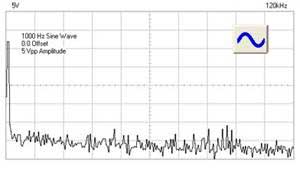
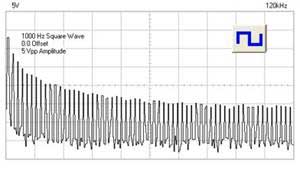
The spectral analysis shown here is the same 1000 Hz tone, displayed here across a wider spectrum in the various notated waveforms. Note how much richer the spectral content is for the square wave. ESPECIALLY take notice that these measurable harmonics reach far outside the typical audio spectrum.
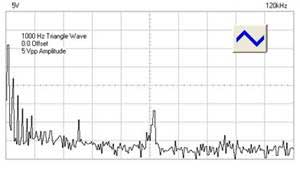
The Triangle Waveform Does include limited harmonics, but not near that exhibited in the square waveform.
It is this both the phenomena of resonance and the harmonic content being generated that are the foundations of the application of Resonant Frequency Therapy.
It is very likely NOT the sound frequencies .but rather harmonics "doing the job"
In the following 2 illustrations hypothetical pathogens A, B, and C have MORS marked in RED. In the first illustration the Frequency being produced is 1000 Hz, represented by the first and largest peak. You can clearly see multiple incremental harmonics. Pathogen A would naturally be affected by the fundamental frequency, as would pathogen B by the harmonic. However, the minimal amplitude required to affect pathogen C is below that required.
By NOT relying on harmonics, we can generate the 13,000 Hz signal to directly "hit" our target. Being the fundamental frequency, our amplitude is at its highest. While we can still rely on harmonics further up the scale, this gives us a "starting point" much closer to the intended target.
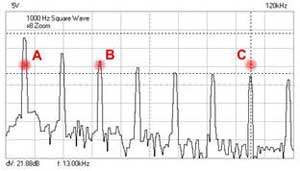
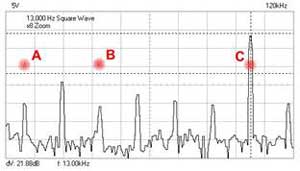
It is important to note, that while sound card and pc speaker applications are quite limited in range, (15-15,000 Hz . maybe 25,000), the new generation of quality function/signal generators typically go into the millions of Hz with fine and precise resolution. While devices of the past have been made to utilize these limited frequency ranges, some of the EMEM-types feel quite fortunate to be able to hit 15,000 Hz as their "top end". Recent developments and better understanding of plasmas coupled with some of the fantastic custom tubes now available have enabled fundamental frequencies in excess of 100,000 Hz, (I've actually gotten over 200,000 Hz on our development system). The new developments in this technology should prove quite exciting over the coming years.
Frequency Lists
Most of us are of course familiar with the frequency lists. These are typically a listing of MORs (Mortal Oscillatory Rates), that is, the frequency (rate) at which a particular pathogen or target is resonant to the point of devitalization, destruction, or is desirably stimulated to bring about an overall beneficial effect. These lists should ONLY be considered "starting points" for your research. Perhaps one of the issues that has perturbed me the most over the years is the poor quality of many of the designs made available to folks over the years. Many of these equipment designs incorporate protocols into their self-contained function generators assigning arbritrary "codes" to the frequencies or frequency sets. The user is isolated to the point they never can know if the frequency is really the one THEY would choose, or if it is in actuality generating the frequency it indicates. Furthermore, many of these devices prohibit the user from implementing accurate control .even when desired. I have checked some of these devices and found that some ate not EVER actually producing the indicated frequency. In many cases it is close, others it may be many Hz away from the indicated frequency. The price the user paid for the device was NOT an indication of accuracy or performance. Some of the most expensive devices are ones I personally found to be "most lacking". However, we must consider the fact that these available frequency lists have been assembled over the years using a wide variety of types of equipment and devices, by people with wide and varying levels of expertise. At the very best, we should consider this ONLY A STARTING POINT for any investigation.
Frequency Accuracy
Accurate, consistent, and reliable performance of signal generation is highly desired for effective targeting and most operations. However, armed with a good understanding of characteristics, attributes, limitations and techniques, even modest equipment can be utilized to provide most users a workable and effective environment.
Most of us are quite aware of our
We have seen, the mortal oscillatory rates of most maladies/pathogens given in the common frequency lists are for very specific frequencies .
In reality, like any other living things, mutations naturally occur. These mutations likely have their own but slightly different MOR, although they will typically be clustered very near the original . In addition, the amplitudes, amount of signal), required to affect the intended targets may also very.
Although accurate targeting of MOR frequency is quite important, failure to consider these adjacent offspring can lead to problems just as bad as the first which does not respond in any way to the frequencies commonly listed. It is just as important to target on those "possible" adjacent pathogens as it is the ones on the list. It is for this reason accurate frequency generation and manipulation is important.
A user which does not take this into consideration can :
- receive less than optimal response/results
- actually create a situation that is far worse and does not respond to any of their "suggested" protocols
- waste a LOT of time, money and effort
The most commonly reported observations from this scenario are a user who may receive basic treatment on a well meaning friend's equipment. The subject will often see an immediate reaction/response. In actuality, the equipment is doing precisely as intended. However, without ALSO addressing the adjacent issues, (often not possible on some machines). The symptoms may return with a vengeance and not respond AT ALL to the original set of frequencies.
In most cases, few people are in a position to better tell what is effectively "working" than the test subject/experimenter themselves. Without this persons responses, understanding and direct participation, successful long term effects are quite limited.
*Note: it is believed by many, that the instability of the equipment utilized during Rife's days was actually a benefit. The frequency instability was likely quite effective in wavering around the single target frequency, actively targeting not only the primarily focus, but also the adjacent mutated offspring as well.
Today's modern equipment is quite stable and good equipment is capable of fractional and intentional specific incremental focus in a controlled manner.
Without a doubt this is an issue that needs attention! .... from several perspectives and several
considerations:
- Mathematical/Hardware Errors: We have long known that there are mathematical error and limitations in the generation processes of BOTH the software AND the PC hardware. We also well know that these errors can vary from PC to PC. This has been well explained, documented, and elaborated on over the years by quite a few excellent researchers. While the end user does NOT have to understand the technical reasons, he most assuredly should be aware that these errors exist. By the same consideration, he should ALSO be made well aware that MANY off the shelf test grade function generators ALSO exhibit a degree of drift and inaccuracy equal to or exceeding those known mathematical and hardware errors or limitations. It should also clearly pointed out, that even the highest dollar function generators must be kept in calibration, (or be self-calibrating), if they are to be used as a reference and for absolute accurate generation.
- Microsoft Windows: ... I probably should NOT even start on this ... I abhor this program and all the technical problems it CAUSES ... which is why I mostly use Linux. I DO realize however this is the ONLY OS many folks feel is practically available to them ... but these inherent problems are also the reason many of the software programs are DOS based, so as NOT to introduce the errors caused by Windows Input/Output control in that operating environment. We simply need to be well aware of this for our future development.
- Sweep/Waver/Deviation are actually just terms for intentional frequency manipulations. We have briefly touched in this in earlier, however, we should also probably consider that even our worst equipment today, is probably more stable than the oscillators of Rife's day. It has been speculated more than once that Rife's successes were NOT based as much on frequency accuracy as the accuracy in hitting the target and natural adjacent mutations by the "drift" inherent in his frequency. Not so surprisingly, many or most of the current Rife specific software includes the ability to artificially emulate this very attribute. One of the topics at this years Rife Conference (and the consensus of many of those attending) was this was INDEED an important attribute and feature to be noted.
- The CAFL List (and others): Brian Mclnturff s Consolidated Annotated Frequency List in my opinion is without a doubt the very best and most up-to-date of "Starting Places" for frequency selection. Nenah Sylver's (aka Nina Silver) excellent book, "The Handbook of Rife Frequency Healing", also has an annotated list and as a printed source, in my opinion, second to none. As researchers and experimenters we should realize several things. These lists are STARTING POINTS ... these are what has been reported by others to be effective for their applications.
Any thinking person should usually also consider and be aware of:
- we do not know the circumstances under which those specific frequencies were tested and
- we do not know the technical capabilities and background of the folks utilizing the equipment
NOR do we necessarily know their criteria. - we have absolutely no idea what type of equipment OR ERROR there was in the user's/submitter's equipment... however... based on personal conversation and history and past posts to the lists ... we can be relatively assured that the users have been generally using the same types of equipment we are using now, with the same types of errors.
- we should remember that individuals may be using any number of schemes to correct known problems or limitations or that their equipment mey not be as sensitive to those limitations BY DESIGN.
- ecause the numbers are presented often vary often times only one Hertz, from one list to another, or even withing the same list, that to me seems to be an excellent indication that the numbers being reported ARE most likely representative of "error"
- without a doubt, resources, information, and technical discussion like this list is terribly important to the development and refinement of this technology ... even if such discussion may be restricted or frowned upon elsewhere.
Effective Targeting
The diagram here represents how important frequency selection, and proper manipulation can be to an effective operating procedure.
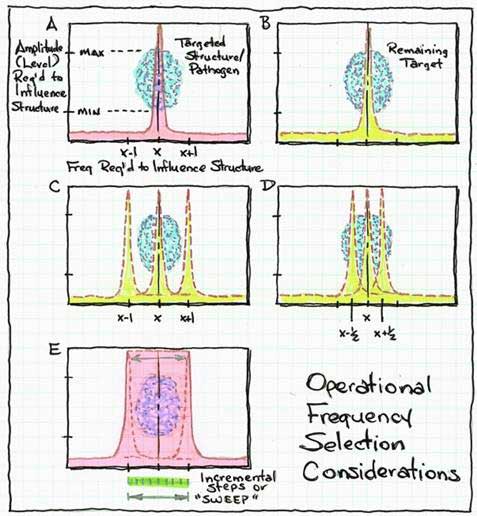
Diagram A shows the spectral emission (red) plotted with x being the MOR. The targeted cells (blue) clustered naturally have a slightly different more and varying minimal amounts of energy are required to devitalize each one. The vertical axis indicates the amount of signal present at the given frequency and noted is the minimal and maximum level of power required for effective destruction.
Diagram B shows in the same original pathogen cluster (blue). However the signal generation, now not present (yellow) shows that those cells that were within the realm of its coverage area are now destroyed. However, adjacent "offspring" have not been effected. Continued application of only the frequency shown in Diagram A will continue to ONLY result in the outcome indicated in Diagram B.
Important Note: Once exposures have ceased, and if no other actions have been taken to devitalize the areas indicated in blue, the pathogen area which HAD effectively been removed will fill back in as mutant offspring of the surviving adjacent surviving/unaffected pathogens continue to propogate.
Diagram C indicates a multiple frequency approach. While the concept is good, the importance of accurate and minute frequency changes become quite apparent. Here, even thought 3 separate frequencies were used, still only one "hit the mark" and in this case, 2/3rds of the time and energies expended were totally wasted.
Diagram D shows that closer frequency increments provide much better and ALMOST complete coverage of the pathogen area but not total coverage of the realm. In many cases, the devitalization is enough to lessen the symptoms enough and relieve the strain on the subjects body whereas the persons immune system can take care of the rest. If the body however can't fight this battle, left without further exposures, like in Diagram B, the pathogen area will fill back in with mutant offspring.
Diagram E indicated a best case scenario whereas small incremental steps (often known as a "sweep") completely cover the desired frequency range. As you can see here, the entire pathogen cluster has been encompassed within the realm of exposure. If indeed it effectively devitalized or destroyed, there is no reason to follow up with later exposures for THIS particular target. In practice however, it remains a wise idea to revisit known "hit" areas to make sure any surviving target is kept to an absolute minimum.
As you can likely summize, user understanding is critical in planning and developing an effective protocol. A thorough understanding will allow meaningful modification and the most effective targeting in the least time and effort expended.

